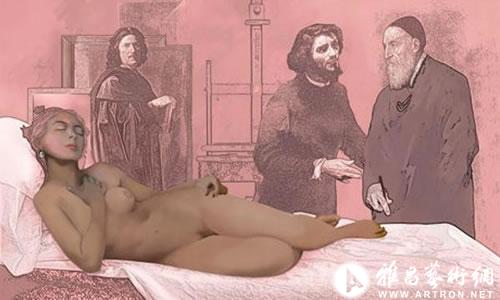编制机构:雅昌艺术市场监测中心(AMMA)

A highly personal exhibition by Richard Hamilton, one of Britain’s most influential artists is scheduled for October at London's National Gallery. It traces an intriguing path leading to his unseen final work, Balzac (a) + (b) + (c). At the time of his death, Hamilton (1922–2011) was planning this show of recent works. It was conceived specifically for the National Gallery and at the time of his passing he was in close contact with curators. The direction Hamilton’s art had taken over recent decades, when his international reputation soared is well represented in this exhibition.e
Just before his death, Hamilton was at work on a major painting based on Honoré de Balzac’s short story 'Le Chef-d’œuvre inconnu' ('The Unknown Masterpiece'). When it became clear he would not live to finish the work, Hamilton decided that the National Gallery exhibition – the first significant one since his death – would culminate in the initial presentation of the large-scale variations on this work, using computer-generated images over-painted by hand. Hamilton had close ties with the National Gallery throughout his career; as a frequent visitor, a teacher guiding his students to its treasures, a curator, and an exhibitor. Many of his later works reflect the inspiration he took from the Gallery’s collection of Old Masters. These include, in addition to 'Balzac (a) + (b) + (c)', a recent painting not shown in Britain before, based on traditional Annunciation iconography. Each one shows three masters of painting – Poussin, Courbet and Titian – contemplating a reclining female nude; together, they suggest how the final work might have evolved.
The exhibition traces several themes of the artist’s career; his exacting attention to single-point perspective; the theme of the beautiful woman and desire; his later interest in space and perspective in works by Renaissance artists; and his pioneering use of the computer. The show also surveys Hamilton's engagement for over half a century with the art of Marcel Duchamp (1887–1968) whose master themes he re-addresses. Indeed, 'Balzac (a) + (b) + (c)' can be seen as the artist’s long-considered response to Duchamp's 'Étant donnés', the secret installation now on display at the Philadelphia Museum of Art, that was the French artist’s final work too, and his most enigmatic masterpiece.
Planned in detail by Hamilton, the exhibition incorporates paintings personally selected by the artist. Most are from the past decade and trace an oblique and enigmatic path to the final work based on Balzac’s short story, 'Balzac (a) + (b) + (c)'. Hamilton had close ties with the National Gallery throughout his career – as a frequent visitor, a teacher guiding his students to its treasures, a curator, and, in the 'Encounters' exhibition of 2000, an exhibitor – and many of his later works reflect the inspiration he took from the Gallery’s collection of Old Masters. These include a recent painting, not shown in Britain before, based on traditional Annunciation iconography.
The exhibition traces several themes of the artist’s career from the 1980s until his death. They include his exacting attention to single-point perspective and the pictorial creation of interior spaces, as seen in works such as 'Lobby', 1985–7; the theme of the beautiful woman and desire; and his later interest in space and perspective in works by Renaissance artists.
The show surveys Hamilton’s engagement over more than 50 years with the art of Marcel Duchamp (1887–1968) whose master themes, including the nude descending a staircase and the bride stripped bare, he re-addresses. Indeed, 'Balzac (a) + (b) + (c)' can be seen as the artist’s long-considered response to Duchamp’s 'Etants donné' (Philadelphia Museum of Art), the secret installation that was the French artist’s final work too, and his most enigmatic masterpiece.
Hamilton’s innovations as a pioneer in the artistic use of the computer and his advocacy of the use of computer technology, collage and photography in his pictures are examined in the exhibition. Even so, he remained primarily a painter.
Born in London in 1922, Hamilton was one of the founders of the Pop Art movement in the 1950s, contributing to the seminal Whitechapel Art Gallery exhibition 'This is Tomorrow' in 1956. His collage 'Just what is it that makes today’s homes so different, so appealing?' used for the show’s posters, became known as one of the earliest works of Pop Art.
A decade later he designed the cover for the Beatles’ 'White Album'. Since then Hamilton has achieved iconic status and received many honours, including the Leone d’Oro (Golden Lion) for his exhibition in the British Pavilion at the 1993 Venice Biennale. At the same time, he was never far from, nor did he avoid, controversy, whether artistic or political.
Richard Hamilton: 'The Late Works' 10 October 2012 – 13 January 2013 Sunley Room, Admission Free 'Balzac (a) + (b) + (c)'

网友评论仅供其表达个人看法,并不表明本站同意其观点或证实其描述。